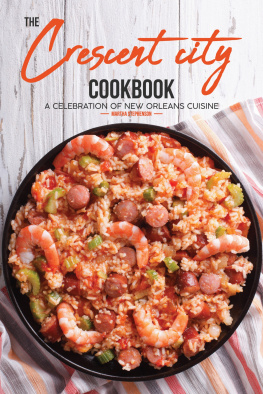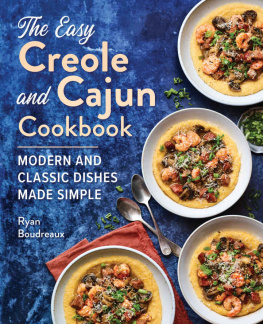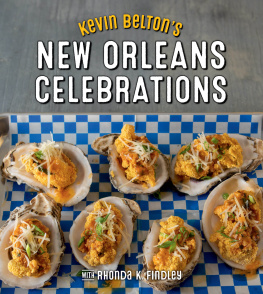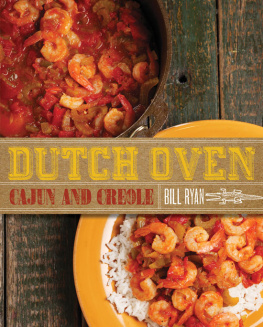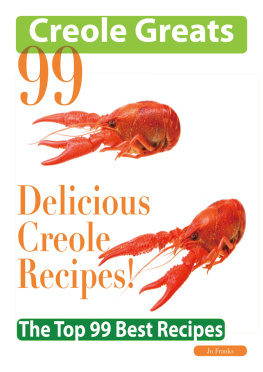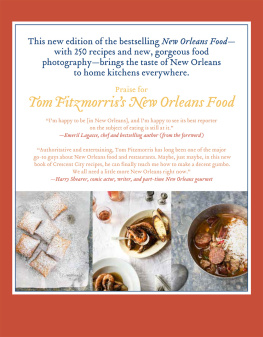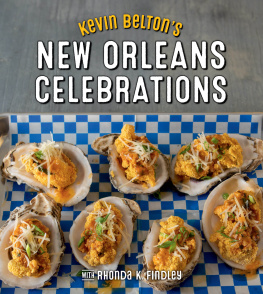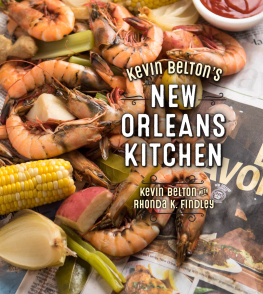Contents
Guide
Page List




THE
LITTLE LOCAL
NEW ORLEANS
COOKBOOK

Recipes for Classic Dishes
STEPHANIE JANE CARTER

For Clementine
CONTENTS


The streets of New Orleans are lined with friendly po-boy shops and tucked-away sno-ball stands; with historic bars proudly stirring up Sazeracs and flashy daiquiri shops that feature drive-thrus; with 150-year-old restaurants that serve flaming desserts tableside; with long oyster bars that make anyone who bellies up to them feel like a king; and with energetic culinary newcomers making waves every day. Its a wonderland with time measured in meals and celebrations.
Some say there are four seasons in Louisianacrawfish, shrimp, oyster, and crabbut there are many more food seasons in New Orleans. The social life of the city revolves around these seasons, with denizens gathering to hunch over tables piled with crawfish, corn, potatoes, sausage, and rolls of paper towels for cleaning messy hands, or to down the gaily colored, sugary king cakes that anchor the revelry during Carnival season. There are seasons for okra, Creole tomatoes, and sno-balls, and many of Louisianas iconic foods even have their own festivals. With contributions from the culinary traditions of African nations, Choctaw Indians, Haitians, Sicilians, Germans, French, Croatians, and so many others, New Orleans revered cuisine is built on giving everyone a turn at the pot. Considered the first true cuisine born in the United Sates, the Crescent Citys foodways emerged from an exchange of ideas and flavors from various groups, all contributing to what we now consider to be Creole food. Its practically built into the definition of Creole food that, in New Orleans, food is an occasion for sharing and connection, one that all New Orleanians consider a part of who they are.

Ask a local where to get the best gumbo, and youll hear my moms house or my grandmothers house. Its not helpful, but its true. More than any other city in the United Sates, food is an identity hereone that all groups, regardless of race, class, social position, hold equally dear. As a result, New Orleans is a town where the home cook is alive and well. Often, the very best versions of classic New Orleans dishes are found in the home; indeed, some are only found there.
Consider this little cookbook an invitation to take your own turn at the pot.
Makes 1 cocktail
In 2008, the Louisiana state legislature declared the Sazerac the official cocktail of New Orleans. This lightly sweet and spicy sipping cocktail should fill an old-fashioned glass just about halfway, a characteristic some say is the perfect expression of New Orleans optimism: The glass is always half full.
Ice cubes
1 4-gram sugar cube
4 dashes Peychauds bitters
2 ounces Sazerac brand rye whiskey
ounce Herbsaint liqueur
Garnish: fresh lemon peel (about 2 inches long)
Fill an old-fashioned glass with ice. In a second glass, muddle together the sugar cube and bitters. Add the rye to the sugar and bitters and stir until the sugar dissolves.
Discard the ice from the first glass. Add the Herbsaint and swirl it around the interior walls of the glass. Discard the Herbsaint and pour the rye mixture into the Herbsaint-coated glass. Twist the lemon peel over the top of the drink to release some of its oils and serve.
Note : The original version of the Sazerac used absinthe.

Makes 1 cocktail
New Orleans love affair with the Green Fairy stretches from when Oscar Wilde, Mark Twain, and other intellectuals sipped it at the Old Absinthe House. The absinthe frapp, created by Cayetano Ferrar at the Old Absinthe House in 1874, was the drink of the bohemian New Orleans culture of the late 1800s. Despite the dark days of Prohibition and the misguided absinthe ban, the Old Absinthe House soldiered on and still stands today, pouring absinthe frapps.
Crushed ice
8 to 10 fresh mint leaves, plus more for garnish
Ice cubes
1 ounce absinthe
ounce rich simple syrup (see Note)
1 egg white (optional)
1 ounce anisette, such as Marie Brizard (optional)
2 ounces club soda
Fill a glass with crushed ice.
Muddle the 8 to 10 mint leaves in the bottom of a cocktail shaker. Add the ice cubes, absinthe, and simple syrup. Add the egg white and anisette, if using. Shake vigorously. Strain into a glass and top with club soda. Garnish with extra mint leaves and serve.
Note : To make rich simple syrup, combine sugar and water in a 2:1 ratio (1 cup sugar to cup water) in a saucepan over medium-low heat and cook, stirring constantly, until the sugar dissolves. Continue cooking for another 5 minutes. Remove from the heat and cool to room temperature.
Makes 1 cocktail
In 1850, when Italian bartender Joseph Santini concocted the first Brandy Crusta (named for the sparkling sugar crust around the rim of the glass) at the Exchange Hotel in New Orleans, he started a revolution. He was the first to add citrus to a cocktail, thus creating the first sour and a template for many well-known cocktails to come.
cup granulated sugar
1 lemon wedge
1 whole lemon
1 ounces Cognac
ounce maraschino liqueur
ounce orange liqueur, such as Grand Marnier or Cointreau
1 teaspoon simple syrup (see Note, page 13)
2 dashes Angostura bitters
Ice
Pour the granulated sugar onto a plate. Rub the rim of a pretty wineglass with the lemon wedge and immediately dip the wet rim into the granulated sugar. Set the glass aside so that the liquid dries and the sugar forms a sparkly crust.
Using a vegetable peeler or paring knife, remove the peel from the whole lemon in 1 long piece about 1 inch wide. Set aside.
Slice open the lemon and squeeze about 1 tablespoons of juice from it. Add to a cocktail shaker.
Add the Cognac, maraschino and orange liqueurs, simple syrup, and bitters to the cocktail shaker and fill with ice. Shake and strain into the sugar-rimmed glass. Submerge the reserved lemon peel and serve.
Makes 1 cocktail
Henry C. Ramos created this silky, white, orange blossom-scented drink at New Orleans Imperial Cabinet Saloon in 1888. By the end of the nineteenth century, the drink grew so popular that Ramos had to employ as many as three dozen shaker boys behind the bar at one time to shake the drinks. Eventually, Ramos sold his recipe to the Roosevelt Hotel, home of the Sazerac Bar, a favorite of Louisianas gregarious longtime governor Huey P. Long. Long loved this ethereal cocktail so much that in 1935, he flew the Sazeracs head bartender to New York to coach bartenders there on the fine art of making it. He referred to it as his gift to New York.


